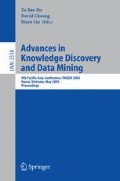Abstract
Finding motifs in time-series is proposed to make clustering of time-series subsequences meaningful, because most existing algorithms of clustering time-series subsequences are reported meaningless in recent studies. The existing motif finding algorithms emphasize the efficiency at the expense of quality, in terms of the number of time-series subsequences in a motif and the total number of motifs found. In this paper, we formalize the problem as a continuous top-k motif balls problem in an m-dimensional space, and propose heuristic approaches that can significantly improve the quality of motifs with reasonable overhead, as shown in our experimental studies.
Access this chapter
Tax calculation will be finalised at checkout
Purchases are for personal use only
Preview
Unable to display preview. Download preview PDF.
References
Bron, C., Kerbosch, J.: Algorithm 457: finding all cliques of an undirected graph. Communications of the ACM 16(9), 575–577 (1973)
Chiu, B., Keogh, E., Lonardi, S.: Probabilistic discovery of time series motifs. In: Proc. of KDD 2003 (2003)
Gärtner, B.: Fast and robust smallest enclosing balls. In: Nešetřil, J. (ed.) ESA 1999. LNCS, vol. 1643, pp. 325–338. Springer, Heidelberg (1999)
Han, J., Kamber, M.: Data Mining: Concepts and Techniques (2001)
Hinnerburg, A., Keim, D.A.: Optimal grid-clustering: Towards breaking the curse of dimensionality in high-dimensional clustering. In: Proc. of VLDB 1999 (1999)
Keogh, E., Lin, J., Truppel, W.: Clustering of time series subsequences is meaningless: Implications for past and future research. In: Proc. of ICDM 2003 (2003)
Lin, J., Keogh, E., Lonardi, S., Patel, P.: Finding motifs in time series. In: Proc. of the 2nd Workshop on Temporal Data Mining, at ACM SIGKDD 2002 (2002)
Patel, P., Keogh, E., Lin, J., Lonardi, S.: Mining motifs in massive time series database. In: Proc. of ICDM 2002 (2002)
Welzl, E.: Smallest enclosing disks (balls and ellipsoids). In: Maurer, H.A. (ed.) New Results and New Trends in Computer Science. LNCS, vol. 555. Springer, Heidelberg (1991)
Author information
Authors and Affiliations
Editor information
Editors and Affiliations
Rights and permissions
Copyright information
© 2005 Springer-Verlag Berlin Heidelberg
About this paper
Cite this paper
Liu, Z., Yu, J.X., Lin, X., Lu, H., Wang, W. (2005). Locating Motifs in Time-Series Data. In: Ho, T.B., Cheung, D., Liu, H. (eds) Advances in Knowledge Discovery and Data Mining. PAKDD 2005. Lecture Notes in Computer Science(), vol 3518. Springer, Berlin, Heidelberg. https://doi.org/10.1007/11430919_41
Download citation
DOI: https://doi.org/10.1007/11430919_41
Publisher Name: Springer, Berlin, Heidelberg
Print ISBN: 978-3-540-26076-9
Online ISBN: 978-3-540-31935-1
eBook Packages: Computer ScienceComputer Science (R0)

